LAW5730C RMIT: Contract Law Principles, Case Studies Analysis
VerifiedAdded on 2022/12/23
|9
|2578
|2
Report
AI Summary
This report provides a detailed analysis of key contract law principles, supported by relevant case studies. It examines specific performance, referencing Goldberger's review and the Instruments Act 1958, particularly Section 126. The report discusses the landmark case of Masters v Cameron in relation to formal contracts and explores the intention to create legal relations, citing Carlill v Carbolic Smoke Ball Company. Furthermore, it delves into undue influence, duress, and unconscionability with cases like Yerkey v. Jones and Blomley v Ryan, highlighting situations where a contract may be deemed voidable. The analysis focuses on how these principles apply in scenarios involving property sales and spousal influence, emphasizing the importance of informed consent and legitimate pressure in contract formation. Desklib provides similar solved assignments and past papers for students.
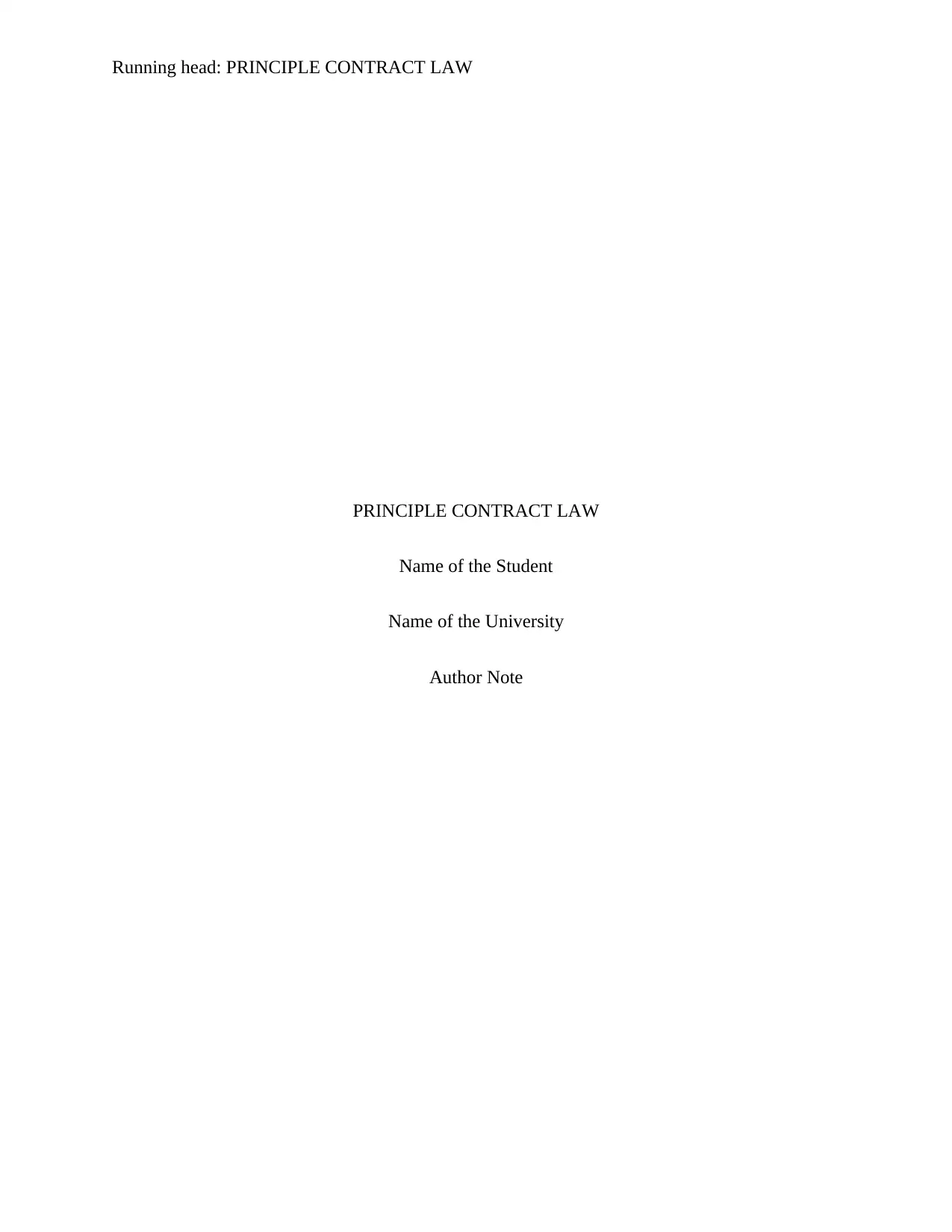
Running head: PRINCIPLE CONTRACT LAW
PRINCIPLE CONTRACT LAW
Name of the Student
Name of the University
Author Note
PRINCIPLE CONTRACT LAW
Name of the Student
Name of the University
Author Note
Paraphrase This Document
Need a fresh take? Get an instant paraphrase of this document with our AI Paraphraser
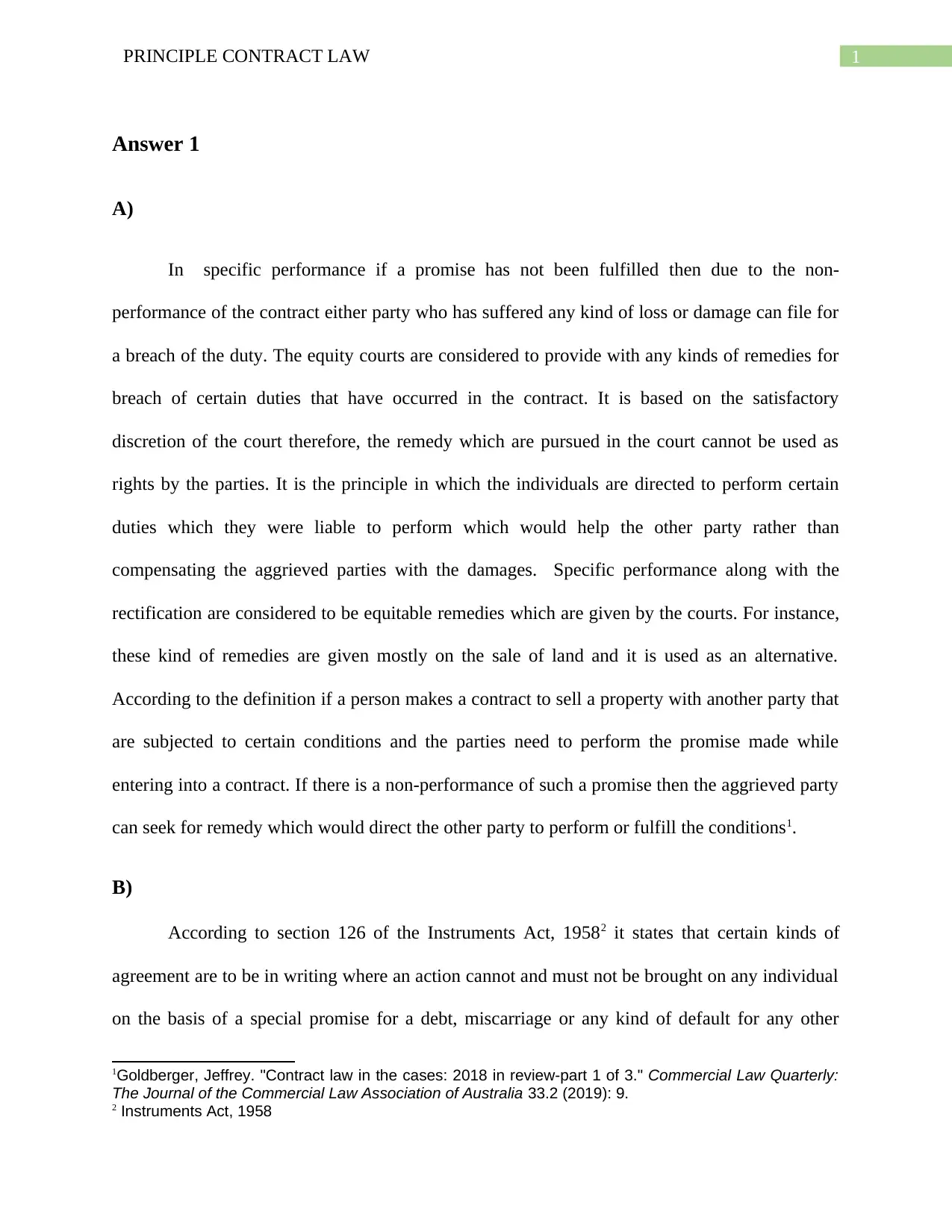
1PRINCIPLE CONTRACT LAW
Answer 1
A)
In specific performance if a promise has not been fulfilled then due to the non-
performance of the contract either party who has suffered any kind of loss or damage can file for
a breach of the duty. The equity courts are considered to provide with any kinds of remedies for
breach of certain duties that have occurred in the contract. It is based on the satisfactory
discretion of the court therefore, the remedy which are pursued in the court cannot be used as
rights by the parties. It is the principle in which the individuals are directed to perform certain
duties which they were liable to perform which would help the other party rather than
compensating the aggrieved parties with the damages. Specific performance along with the
rectification are considered to be equitable remedies which are given by the courts. For instance,
these kind of remedies are given mostly on the sale of land and it is used as an alternative.
According to the definition if a person makes a contract to sell a property with another party that
are subjected to certain conditions and the parties need to perform the promise made while
entering into a contract. If there is a non-performance of such a promise then the aggrieved party
can seek for remedy which would direct the other party to perform or fulfill the conditions1.
B)
According to section 126 of the Instruments Act, 19582 it states that certain kinds of
agreement are to be in writing where an action cannot and must not be brought on any individual
on the basis of a special promise for a debt, miscarriage or any kind of default for any other
1Goldberger, Jeffrey. "Contract law in the cases: 2018 in review-part 1 of 3." Commercial Law Quarterly:
The Journal of the Commercial Law Association of Australia 33.2 (2019): 9.
2 Instruments Act, 1958
Answer 1
A)
In specific performance if a promise has not been fulfilled then due to the non-
performance of the contract either party who has suffered any kind of loss or damage can file for
a breach of the duty. The equity courts are considered to provide with any kinds of remedies for
breach of certain duties that have occurred in the contract. It is based on the satisfactory
discretion of the court therefore, the remedy which are pursued in the court cannot be used as
rights by the parties. It is the principle in which the individuals are directed to perform certain
duties which they were liable to perform which would help the other party rather than
compensating the aggrieved parties with the damages. Specific performance along with the
rectification are considered to be equitable remedies which are given by the courts. For instance,
these kind of remedies are given mostly on the sale of land and it is used as an alternative.
According to the definition if a person makes a contract to sell a property with another party that
are subjected to certain conditions and the parties need to perform the promise made while
entering into a contract. If there is a non-performance of such a promise then the aggrieved party
can seek for remedy which would direct the other party to perform or fulfill the conditions1.
B)
According to section 126 of the Instruments Act, 19582 it states that certain kinds of
agreement are to be in writing where an action cannot and must not be brought on any individual
on the basis of a special promise for a debt, miscarriage or any kind of default for any other
1Goldberger, Jeffrey. "Contract law in the cases: 2018 in review-part 1 of 3." Commercial Law Quarterly:
The Journal of the Commercial Law Association of Australia 33.2 (2019): 9.
2 Instruments Act, 1958
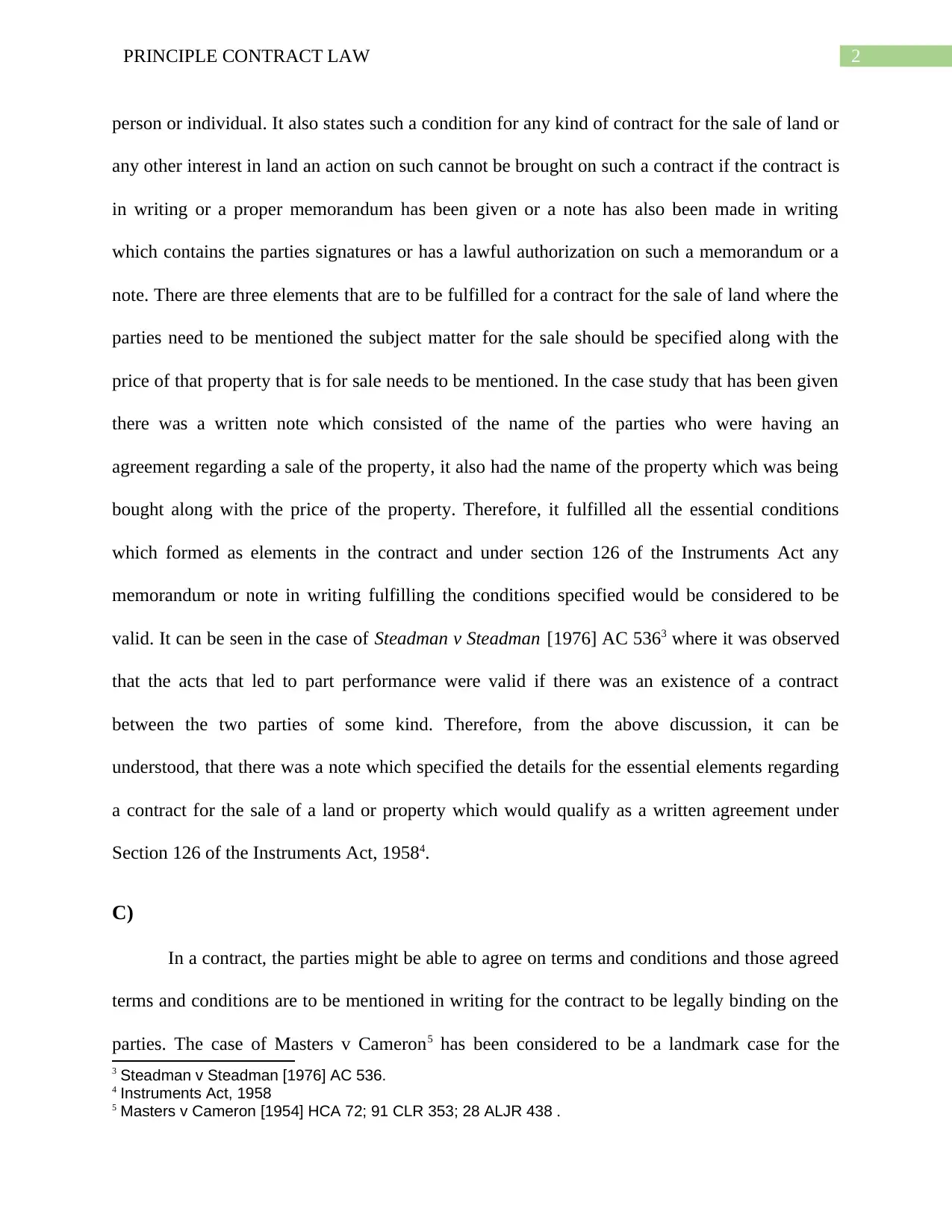
2PRINCIPLE CONTRACT LAW
person or individual. It also states such a condition for any kind of contract for the sale of land or
any other interest in land an action on such cannot be brought on such a contract if the contract is
in writing or a proper memorandum has been given or a note has also been made in writing
which contains the parties signatures or has a lawful authorization on such a memorandum or a
note. There are three elements that are to be fulfilled for a contract for the sale of land where the
parties need to be mentioned the subject matter for the sale should be specified along with the
price of that property that is for sale needs to be mentioned. In the case study that has been given
there was a written note which consisted of the name of the parties who were having an
agreement regarding a sale of the property, it also had the name of the property which was being
bought along with the price of the property. Therefore, it fulfilled all the essential conditions
which formed as elements in the contract and under section 126 of the Instruments Act any
memorandum or note in writing fulfilling the conditions specified would be considered to be
valid. It can be seen in the case of Steadman v Steadman [1976] AC 5363 where it was observed
that the acts that led to part performance were valid if there was an existence of a contract
between the two parties of some kind. Therefore, from the above discussion, it can be
understood, that there was a note which specified the details for the essential elements regarding
a contract for the sale of a land or property which would qualify as a written agreement under
Section 126 of the Instruments Act, 19584.
C)
In a contract, the parties might be able to agree on terms and conditions and those agreed
terms and conditions are to be mentioned in writing for the contract to be legally binding on the
parties. The case of Masters v Cameron5 has been considered to be a landmark case for the
3 Steadman v Steadman [1976] AC 536.
4 Instruments Act, 1958
5 Masters v Cameron [1954] HCA 72; 91 CLR 353; 28 ALJR 438 .
person or individual. It also states such a condition for any kind of contract for the sale of land or
any other interest in land an action on such cannot be brought on such a contract if the contract is
in writing or a proper memorandum has been given or a note has also been made in writing
which contains the parties signatures or has a lawful authorization on such a memorandum or a
note. There are three elements that are to be fulfilled for a contract for the sale of land where the
parties need to be mentioned the subject matter for the sale should be specified along with the
price of that property that is for sale needs to be mentioned. In the case study that has been given
there was a written note which consisted of the name of the parties who were having an
agreement regarding a sale of the property, it also had the name of the property which was being
bought along with the price of the property. Therefore, it fulfilled all the essential conditions
which formed as elements in the contract and under section 126 of the Instruments Act any
memorandum or note in writing fulfilling the conditions specified would be considered to be
valid. It can be seen in the case of Steadman v Steadman [1976] AC 5363 where it was observed
that the acts that led to part performance were valid if there was an existence of a contract
between the two parties of some kind. Therefore, from the above discussion, it can be
understood, that there was a note which specified the details for the essential elements regarding
a contract for the sale of a land or property which would qualify as a written agreement under
Section 126 of the Instruments Act, 19584.
C)
In a contract, the parties might be able to agree on terms and conditions and those agreed
terms and conditions are to be mentioned in writing for the contract to be legally binding on the
parties. The case of Masters v Cameron5 has been considered to be a landmark case for the
3 Steadman v Steadman [1976] AC 536.
4 Instruments Act, 1958
5 Masters v Cameron [1954] HCA 72; 91 CLR 353; 28 ALJR 438 .
⊘ This is a preview!⊘
Do you want full access?
Subscribe today to unlock all pages.

Trusted by 1+ million students worldwide
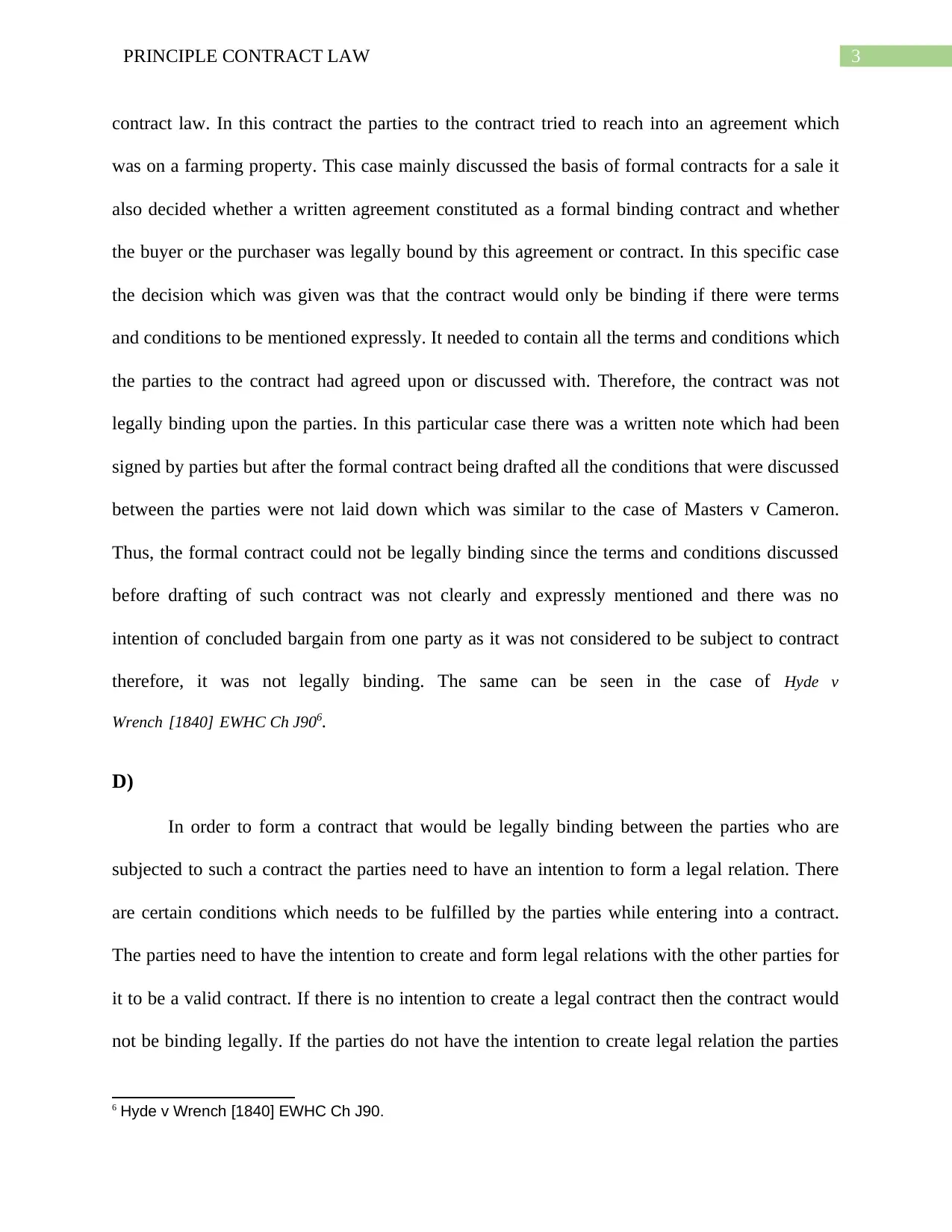
3PRINCIPLE CONTRACT LAW
contract law. In this contract the parties to the contract tried to reach into an agreement which
was on a farming property. This case mainly discussed the basis of formal contracts for a sale it
also decided whether a written agreement constituted as a formal binding contract and whether
the buyer or the purchaser was legally bound by this agreement or contract. In this specific case
the decision which was given was that the contract would only be binding if there were terms
and conditions to be mentioned expressly. It needed to contain all the terms and conditions which
the parties to the contract had agreed upon or discussed with. Therefore, the contract was not
legally binding upon the parties. In this particular case there was a written note which had been
signed by parties but after the formal contract being drafted all the conditions that were discussed
between the parties were not laid down which was similar to the case of Masters v Cameron.
Thus, the formal contract could not be legally binding since the terms and conditions discussed
before drafting of such contract was not clearly and expressly mentioned and there was no
intention of concluded bargain from one party as it was not considered to be subject to contract
therefore, it was not legally binding. The same can be seen in the case of Hyde v
Wrench [1840] EWHC Ch J906.
D)
In order to form a contract that would be legally binding between the parties who are
subjected to such a contract the parties need to have an intention to form a legal relation. There
are certain conditions which needs to be fulfilled by the parties while entering into a contract.
The parties need to have the intention to create and form legal relations with the other parties for
it to be a valid contract. If there is no intention to create a legal contract then the contract would
not be binding legally. If the parties do not have the intention to create legal relation the parties
6 Hyde v Wrench [1840] EWHC Ch J90.
contract law. In this contract the parties to the contract tried to reach into an agreement which
was on a farming property. This case mainly discussed the basis of formal contracts for a sale it
also decided whether a written agreement constituted as a formal binding contract and whether
the buyer or the purchaser was legally bound by this agreement or contract. In this specific case
the decision which was given was that the contract would only be binding if there were terms
and conditions to be mentioned expressly. It needed to contain all the terms and conditions which
the parties to the contract had agreed upon or discussed with. Therefore, the contract was not
legally binding upon the parties. In this particular case there was a written note which had been
signed by parties but after the formal contract being drafted all the conditions that were discussed
between the parties were not laid down which was similar to the case of Masters v Cameron.
Thus, the formal contract could not be legally binding since the terms and conditions discussed
before drafting of such contract was not clearly and expressly mentioned and there was no
intention of concluded bargain from one party as it was not considered to be subject to contract
therefore, it was not legally binding. The same can be seen in the case of Hyde v
Wrench [1840] EWHC Ch J906.
D)
In order to form a contract that would be legally binding between the parties who are
subjected to such a contract the parties need to have an intention to form a legal relation. There
are certain conditions which needs to be fulfilled by the parties while entering into a contract.
The parties need to have the intention to create and form legal relations with the other parties for
it to be a valid contract. If there is no intention to create a legal contract then the contract would
not be binding legally. If the parties do not have the intention to create legal relation the parties
6 Hyde v Wrench [1840] EWHC Ch J90.
Paraphrase This Document
Need a fresh take? Get an instant paraphrase of this document with our AI Paraphraser
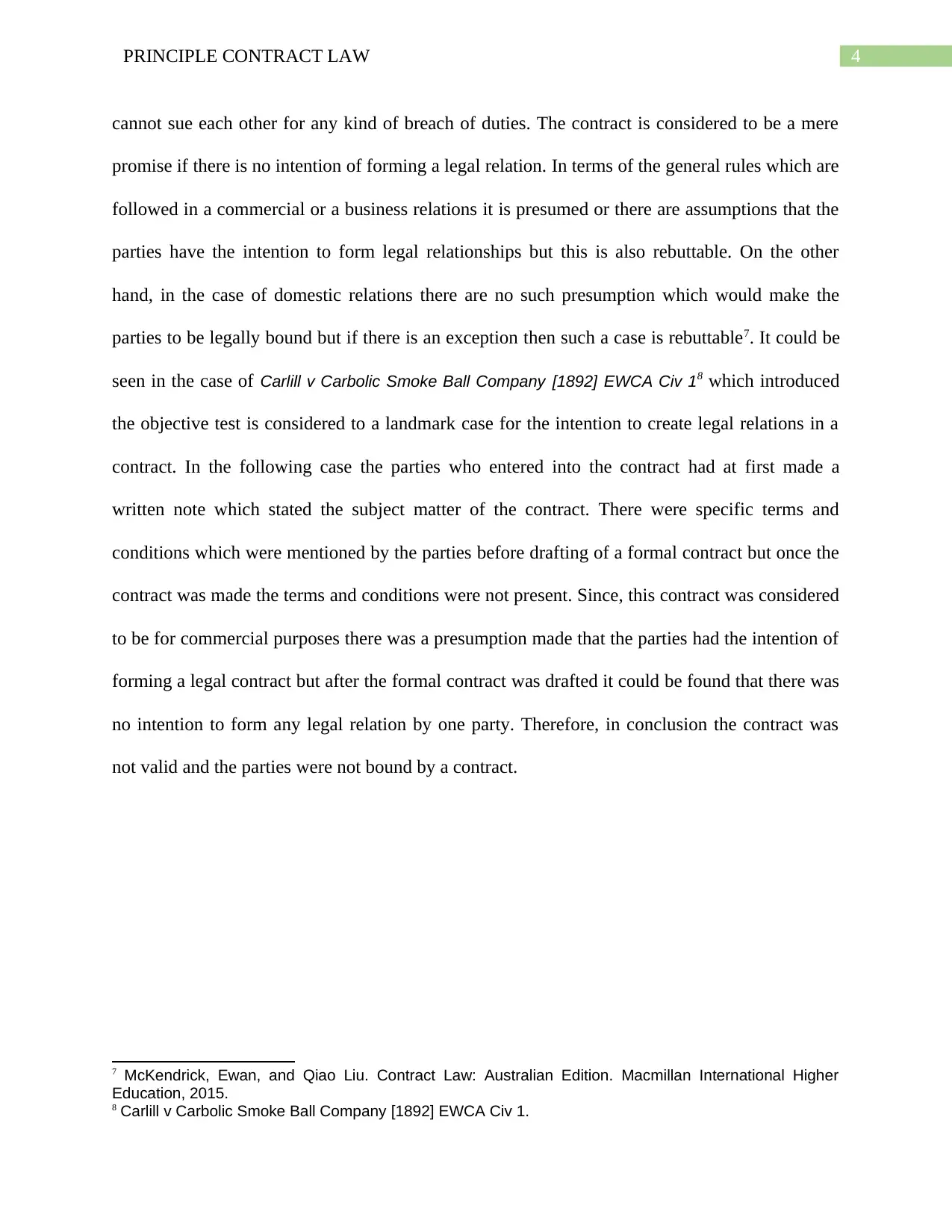
4PRINCIPLE CONTRACT LAW
cannot sue each other for any kind of breach of duties. The contract is considered to be a mere
promise if there is no intention of forming a legal relation. In terms of the general rules which are
followed in a commercial or a business relations it is presumed or there are assumptions that the
parties have the intention to form legal relationships but this is also rebuttable. On the other
hand, in the case of domestic relations there are no such presumption which would make the
parties to be legally bound but if there is an exception then such a case is rebuttable7. It could be
seen in the case of Carlill v Carbolic Smoke Ball Company [1892] EWCA Civ 18 which introduced
the objective test is considered to a landmark case for the intention to create legal relations in a
contract. In the following case the parties who entered into the contract had at first made a
written note which stated the subject matter of the contract. There were specific terms and
conditions which were mentioned by the parties before drafting of a formal contract but once the
contract was made the terms and conditions were not present. Since, this contract was considered
to be for commercial purposes there was a presumption made that the parties had the intention of
forming a legal contract but after the formal contract was drafted it could be found that there was
no intention to form any legal relation by one party. Therefore, in conclusion the contract was
not valid and the parties were not bound by a contract.
7 McKendrick, Ewan, and Qiao Liu. Contract Law: Australian Edition. Macmillan International Higher
Education, 2015.
8 Carlill v Carbolic Smoke Ball Company [1892] EWCA Civ 1.
cannot sue each other for any kind of breach of duties. The contract is considered to be a mere
promise if there is no intention of forming a legal relation. In terms of the general rules which are
followed in a commercial or a business relations it is presumed or there are assumptions that the
parties have the intention to form legal relationships but this is also rebuttable. On the other
hand, in the case of domestic relations there are no such presumption which would make the
parties to be legally bound but if there is an exception then such a case is rebuttable7. It could be
seen in the case of Carlill v Carbolic Smoke Ball Company [1892] EWCA Civ 18 which introduced
the objective test is considered to a landmark case for the intention to create legal relations in a
contract. In the following case the parties who entered into the contract had at first made a
written note which stated the subject matter of the contract. There were specific terms and
conditions which were mentioned by the parties before drafting of a formal contract but once the
contract was made the terms and conditions were not present. Since, this contract was considered
to be for commercial purposes there was a presumption made that the parties had the intention of
forming a legal contract but after the formal contract was drafted it could be found that there was
no intention to form any legal relation by one party. Therefore, in conclusion the contract was
not valid and the parties were not bound by a contract.
7 McKendrick, Ewan, and Qiao Liu. Contract Law: Australian Edition. Macmillan International Higher
Education, 2015.
8 Carlill v Carbolic Smoke Ball Company [1892] EWCA Civ 1.
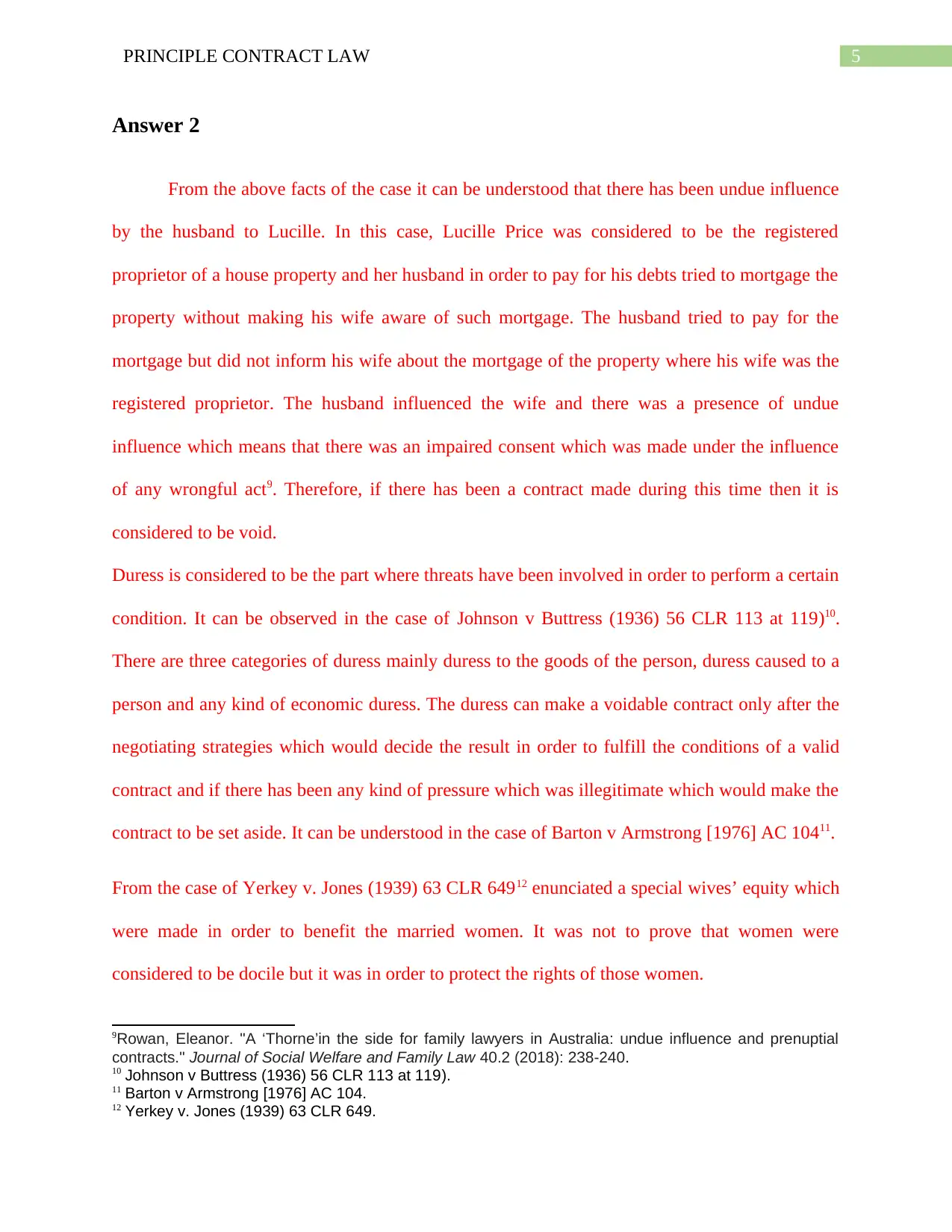
5PRINCIPLE CONTRACT LAW
Answer 2
From the above facts of the case it can be understood that there has been undue influence
by the husband to Lucille. In this case, Lucille Price was considered to be the registered
proprietor of a house property and her husband in order to pay for his debts tried to mortgage the
property without making his wife aware of such mortgage. The husband tried to pay for the
mortgage but did not inform his wife about the mortgage of the property where his wife was the
registered proprietor. The husband influenced the wife and there was a presence of undue
influence which means that there was an impaired consent which was made under the influence
of any wrongful act9. Therefore, if there has been a contract made during this time then it is
considered to be void.
Duress is considered to be the part where threats have been involved in order to perform a certain
condition. It can be observed in the case of Johnson v Buttress (1936) 56 CLR 113 at 119)10.
There are three categories of duress mainly duress to the goods of the person, duress caused to a
person and any kind of economic duress. The duress can make a voidable contract only after the
negotiating strategies which would decide the result in order to fulfill the conditions of a valid
contract and if there has been any kind of pressure which was illegitimate which would make the
contract to be set aside. It can be understood in the case of Barton v Armstrong [1976] AC 10411.
From the case of Yerkey v. Jones (1939) 63 CLR 64912 enunciated a special wives’ equity which
were made in order to benefit the married women. It was not to prove that women were
considered to be docile but it was in order to protect the rights of those women.
9Rowan, Eleanor. "A ‘Thorne’in the side for family lawyers in Australia: undue influence and prenuptial
contracts." Journal of Social Welfare and Family Law 40.2 (2018): 238-240.
10 Johnson v Buttress (1936) 56 CLR 113 at 119).
11 Barton v Armstrong [1976] AC 104.
12 Yerkey v. Jones (1939) 63 CLR 649.
Answer 2
From the above facts of the case it can be understood that there has been undue influence
by the husband to Lucille. In this case, Lucille Price was considered to be the registered
proprietor of a house property and her husband in order to pay for his debts tried to mortgage the
property without making his wife aware of such mortgage. The husband tried to pay for the
mortgage but did not inform his wife about the mortgage of the property where his wife was the
registered proprietor. The husband influenced the wife and there was a presence of undue
influence which means that there was an impaired consent which was made under the influence
of any wrongful act9. Therefore, if there has been a contract made during this time then it is
considered to be void.
Duress is considered to be the part where threats have been involved in order to perform a certain
condition. It can be observed in the case of Johnson v Buttress (1936) 56 CLR 113 at 119)10.
There are three categories of duress mainly duress to the goods of the person, duress caused to a
person and any kind of economic duress. The duress can make a voidable contract only after the
negotiating strategies which would decide the result in order to fulfill the conditions of a valid
contract and if there has been any kind of pressure which was illegitimate which would make the
contract to be set aside. It can be understood in the case of Barton v Armstrong [1976] AC 10411.
From the case of Yerkey v. Jones (1939) 63 CLR 64912 enunciated a special wives’ equity which
were made in order to benefit the married women. It was not to prove that women were
considered to be docile but it was in order to protect the rights of those women.
9Rowan, Eleanor. "A ‘Thorne’in the side for family lawyers in Australia: undue influence and prenuptial
contracts." Journal of Social Welfare and Family Law 40.2 (2018): 238-240.
10 Johnson v Buttress (1936) 56 CLR 113 at 119).
11 Barton v Armstrong [1976] AC 104.
12 Yerkey v. Jones (1939) 63 CLR 649.
⊘ This is a preview!⊘
Do you want full access?
Subscribe today to unlock all pages.

Trusted by 1+ million students worldwide
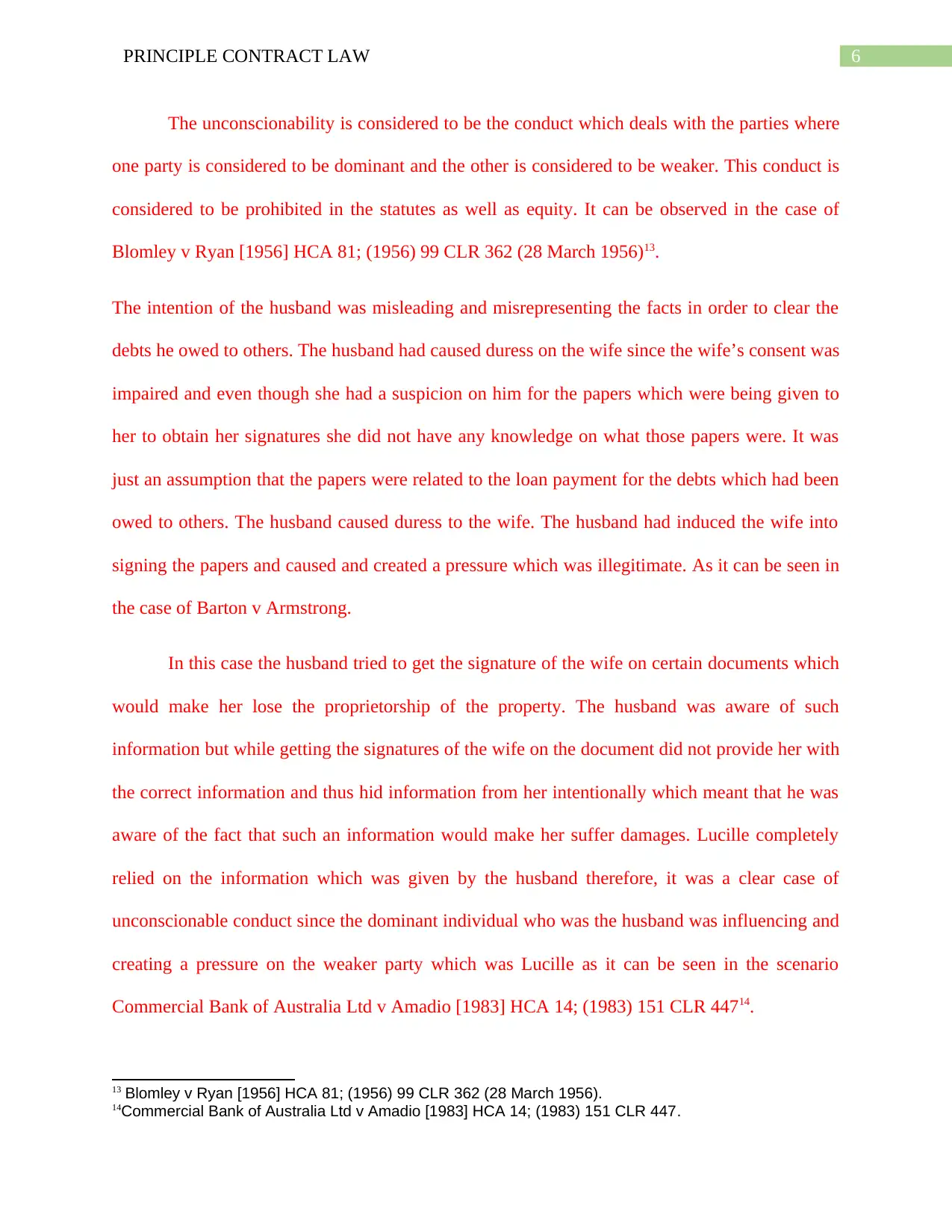
6PRINCIPLE CONTRACT LAW
The unconscionability is considered to be the conduct which deals with the parties where
one party is considered to be dominant and the other is considered to be weaker. This conduct is
considered to be prohibited in the statutes as well as equity. It can be observed in the case of
Blomley v Ryan [1956] HCA 81; (1956) 99 CLR 362 (28 March 1956)13.
The intention of the husband was misleading and misrepresenting the facts in order to clear the
debts he owed to others. The husband had caused duress on the wife since the wife’s consent was
impaired and even though she had a suspicion on him for the papers which were being given to
her to obtain her signatures she did not have any knowledge on what those papers were. It was
just an assumption that the papers were related to the loan payment for the debts which had been
owed to others. The husband caused duress to the wife. The husband had induced the wife into
signing the papers and caused and created a pressure which was illegitimate. As it can be seen in
the case of Barton v Armstrong.
In this case the husband tried to get the signature of the wife on certain documents which
would make her lose the proprietorship of the property. The husband was aware of such
information but while getting the signatures of the wife on the document did not provide her with
the correct information and thus hid information from her intentionally which meant that he was
aware of the fact that such an information would make her suffer damages. Lucille completely
relied on the information which was given by the husband therefore, it was a clear case of
unconscionable conduct since the dominant individual who was the husband was influencing and
creating a pressure on the weaker party which was Lucille as it can be seen in the scenario
Commercial Bank of Australia Ltd v Amadio [1983] HCA 14; (1983) 151 CLR 44714.
13 Blomley v Ryan [1956] HCA 81; (1956) 99 CLR 362 (28 March 1956).
14Commercial Bank of Australia Ltd v Amadio [1983] HCA 14; (1983) 151 CLR 447.
The unconscionability is considered to be the conduct which deals with the parties where
one party is considered to be dominant and the other is considered to be weaker. This conduct is
considered to be prohibited in the statutes as well as equity. It can be observed in the case of
Blomley v Ryan [1956] HCA 81; (1956) 99 CLR 362 (28 March 1956)13.
The intention of the husband was misleading and misrepresenting the facts in order to clear the
debts he owed to others. The husband had caused duress on the wife since the wife’s consent was
impaired and even though she had a suspicion on him for the papers which were being given to
her to obtain her signatures she did not have any knowledge on what those papers were. It was
just an assumption that the papers were related to the loan payment for the debts which had been
owed to others. The husband caused duress to the wife. The husband had induced the wife into
signing the papers and caused and created a pressure which was illegitimate. As it can be seen in
the case of Barton v Armstrong.
In this case the husband tried to get the signature of the wife on certain documents which
would make her lose the proprietorship of the property. The husband was aware of such
information but while getting the signatures of the wife on the document did not provide her with
the correct information and thus hid information from her intentionally which meant that he was
aware of the fact that such an information would make her suffer damages. Lucille completely
relied on the information which was given by the husband therefore, it was a clear case of
unconscionable conduct since the dominant individual who was the husband was influencing and
creating a pressure on the weaker party which was Lucille as it can be seen in the scenario
Commercial Bank of Australia Ltd v Amadio [1983] HCA 14; (1983) 151 CLR 44714.
13 Blomley v Ryan [1956] HCA 81; (1956) 99 CLR 362 (28 March 1956).
14Commercial Bank of Australia Ltd v Amadio [1983] HCA 14; (1983) 151 CLR 447.
Paraphrase This Document
Need a fresh take? Get an instant paraphrase of this document with our AI Paraphraser

7PRINCIPLE CONTRACT LAW
Thus, from the above discussion it can be concluded, that Lucille was clearly put pressure
on by her husband and the husband had committed duress to the person where Lucille could seek
and had carried out the unconscionable conduct.
Thus, from the above discussion it can be concluded, that Lucille was clearly put pressure
on by her husband and the husband had committed duress to the person where Lucille could seek
and had carried out the unconscionable conduct.
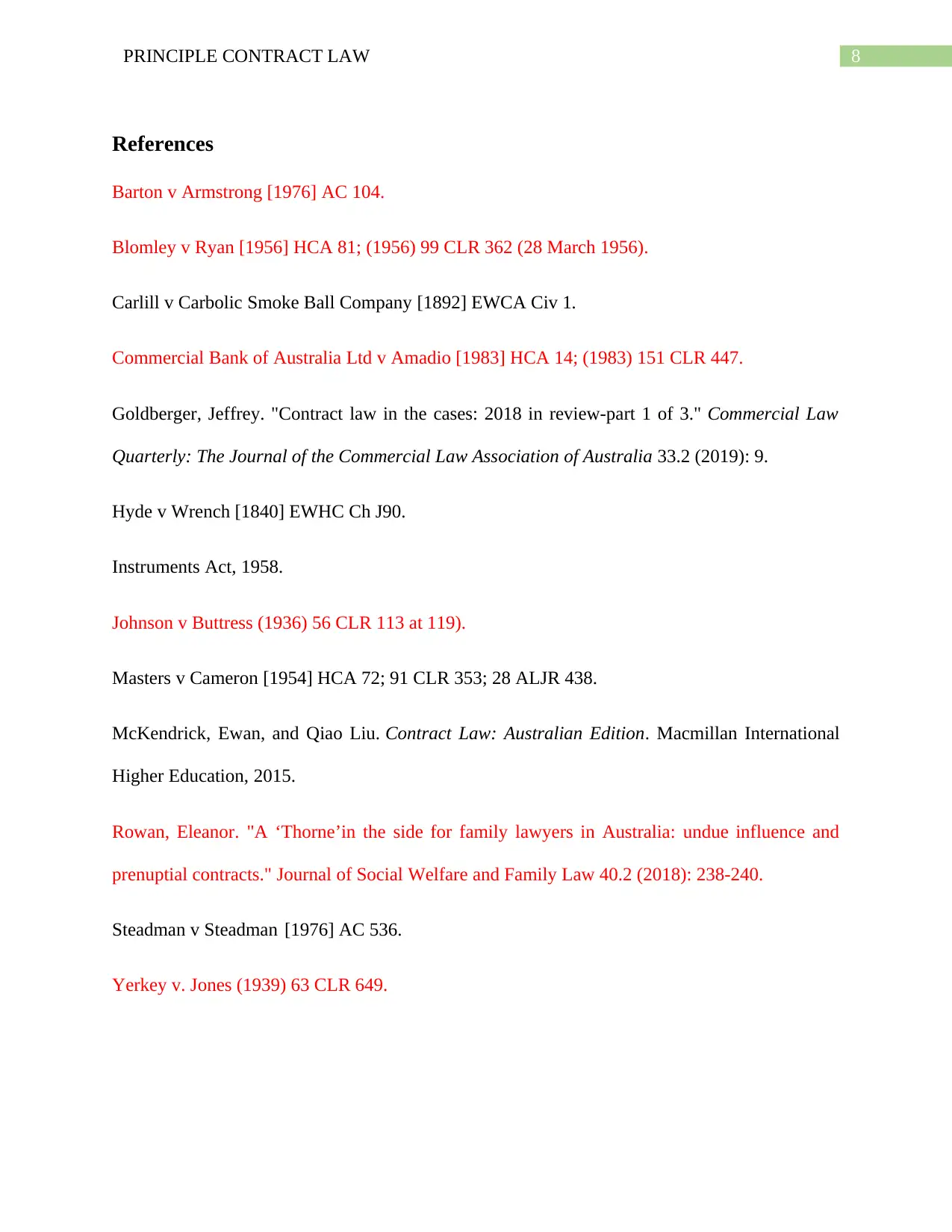
8PRINCIPLE CONTRACT LAW
References
Barton v Armstrong [1976] AC 104.
Blomley v Ryan [1956] HCA 81; (1956) 99 CLR 362 (28 March 1956).
Carlill v Carbolic Smoke Ball Company [1892] EWCA Civ 1.
Commercial Bank of Australia Ltd v Amadio [1983] HCA 14; (1983) 151 CLR 447.
Goldberger, Jeffrey. "Contract law in the cases: 2018 in review-part 1 of 3." Commercial Law
Quarterly: The Journal of the Commercial Law Association of Australia 33.2 (2019): 9.
Hyde v Wrench [1840] EWHC Ch J90.
Instruments Act, 1958.
Johnson v Buttress (1936) 56 CLR 113 at 119).
Masters v Cameron [1954] HCA 72; 91 CLR 353; 28 ALJR 438.
McKendrick, Ewan, and Qiao Liu. Contract Law: Australian Edition. Macmillan International
Higher Education, 2015.
Rowan, Eleanor. "A ‘Thorne’in the side for family lawyers in Australia: undue influence and
prenuptial contracts." Journal of Social Welfare and Family Law 40.2 (2018): 238-240.
Steadman v Steadman [1976] AC 536.
Yerkey v. Jones (1939) 63 CLR 649.
References
Barton v Armstrong [1976] AC 104.
Blomley v Ryan [1956] HCA 81; (1956) 99 CLR 362 (28 March 1956).
Carlill v Carbolic Smoke Ball Company [1892] EWCA Civ 1.
Commercial Bank of Australia Ltd v Amadio [1983] HCA 14; (1983) 151 CLR 447.
Goldberger, Jeffrey. "Contract law in the cases: 2018 in review-part 1 of 3." Commercial Law
Quarterly: The Journal of the Commercial Law Association of Australia 33.2 (2019): 9.
Hyde v Wrench [1840] EWHC Ch J90.
Instruments Act, 1958.
Johnson v Buttress (1936) 56 CLR 113 at 119).
Masters v Cameron [1954] HCA 72; 91 CLR 353; 28 ALJR 438.
McKendrick, Ewan, and Qiao Liu. Contract Law: Australian Edition. Macmillan International
Higher Education, 2015.
Rowan, Eleanor. "A ‘Thorne’in the side for family lawyers in Australia: undue influence and
prenuptial contracts." Journal of Social Welfare and Family Law 40.2 (2018): 238-240.
Steadman v Steadman [1976] AC 536.
Yerkey v. Jones (1939) 63 CLR 649.
⊘ This is a preview!⊘
Do you want full access?
Subscribe today to unlock all pages.

Trusted by 1+ million students worldwide
1 out of 9
Related Documents
Your All-in-One AI-Powered Toolkit for Academic Success.
+13062052269
info@desklib.com
Available 24*7 on WhatsApp / Email
![[object Object]](/_next/static/media/star-bottom.7253800d.svg)
Unlock your academic potential
Copyright © 2020–2025 A2Z Services. All Rights Reserved. Developed and managed by ZUCOL.





